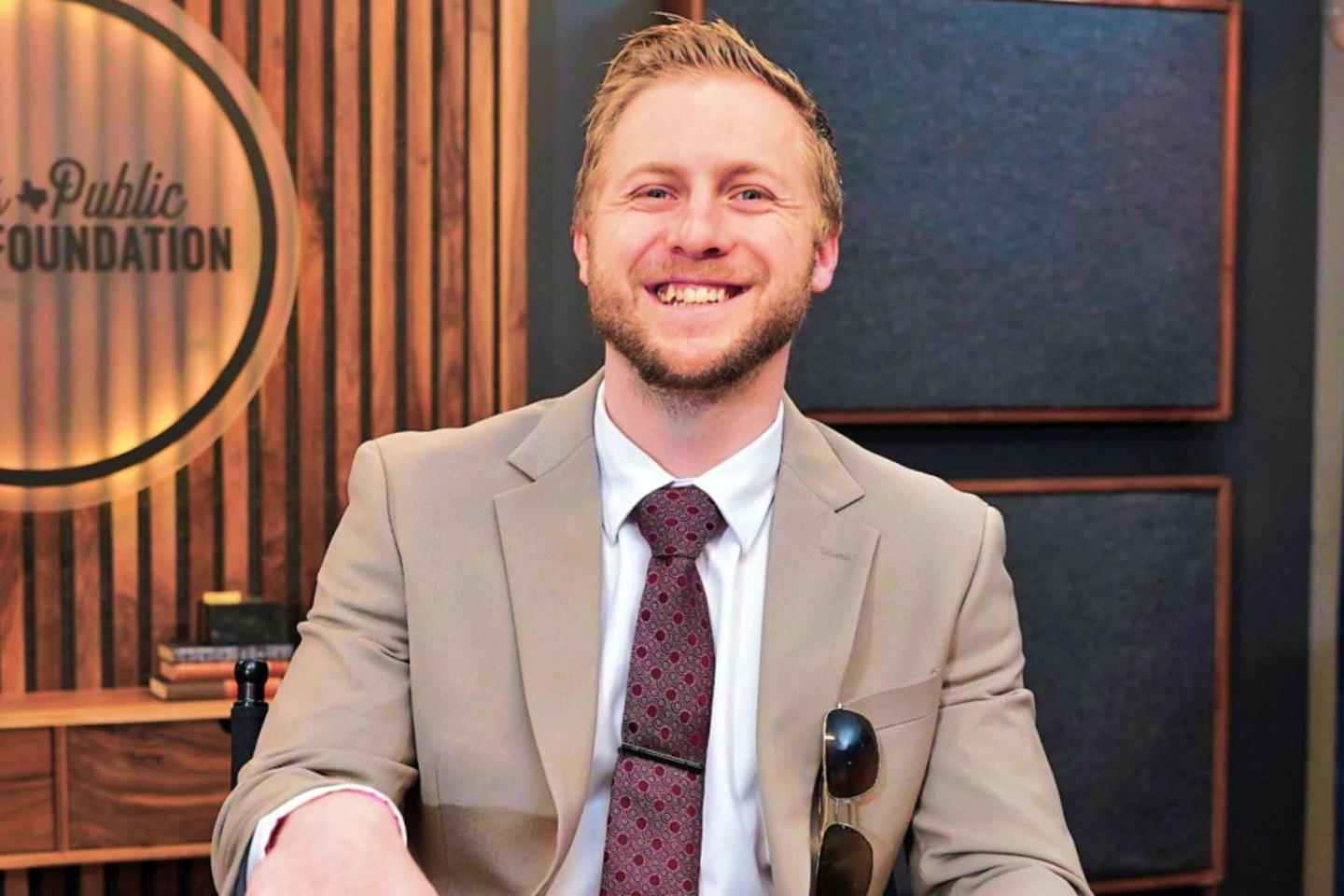This article was originally published by Stand Together Trust.
America needs health care innovation and principled policy reform more than ever.
Rising costs, sicker patients, and doctor shortages plague an overburdened and needlessly complicated system. Patients fear rising insurance premiums and astronomical medical bills. Crippling, top-down regulations imposed by broken laws, poor bureaucrat interpretation, and special interest lobbying prevent doctors from giving patients the best care possible.
Fortunately, solutions to these problems are within grasp.
Tanner Aliff is one of the many policy and health experts transforming our health care system, starting in the states. As the Policy Director for Right on Healthcare at the Texas Public Policy Foundation, Aliff researches reforms addressing price transparency, state employee health plans, anti-competitive health care regulations, hospital financing, and telehealth, among other issues affecting patients and medical providers.
Stand Together Trust invests in health care changemakers like the Texas Public Policy Foundation to ensure Americans have greater access and better health care.
Stand Together Trust spoke with Aliff about the need for reform, his research and policy work, and what ideas stand to innovate health care.
Stand Together Trust: You've dedicated your career to health care, focusing on fixing a broken system. Can you tell us why you are compelled to work for health care reform?
Aliff: When I realized the financing and administration of health care often hurt patients more than their own illnesses or injuries, I knew it was health care policy that needed the most "curing." As an undergrad, I planned to have a career in neuropsychology but changed course after working as a Constant Observer at Providence Health. While at Providence, I worked graveyard shifts in the emergency department (ED) and monitored the conditions of at-risk patients. Nothing crazy, just keeping an eye on patients, taking notes, and flagging the attending physician or nurses if a complication popped up.
One night the police brought in a patient suspected to be under the influence and had jumped off a roof in a nearby neighborhood. The ED team took care of the bodily injuries, but a Doctor of Psychology (PsyD) was called in due to suspicion of substance abuse. I chatted with the PsyD who conducted the psych evaluation. The patient was transient, had a long family history of mental health issues, had a smorgasbord of diagnosable disorders, and seemed to pose a continued risk to themselves. The PsyD wanted the patient committed to an inpatient facility, but my hospital didn't have a psychiatric ward, meaning the PsyD could only make a referral. Consequently, the patient, who didn't own a car, was "referred" to an outpatient facility about 13 miles away. Long story short, I had a sinking feeling the patient wasn't going, or able, to get treatment.
Once the patient was patched up and discharged, a seasoned nurse mentioned that it was the seventh or ninth time they saw the patient in the ED that month. That shocked me. However, what shocked me more, was that the patient was enrolled in Oregon Medicaid. Essentially, the state was spending thousands of taxpayer dollars on emergency services, that didn't address the root mental health issues repeatedly bringing the patient back to the emergency room. It was in that instance I realized how the health care system was hurting patients more than their own ailments.
It wasn't one person's or organization's fault that the patient didn't get the care they needed; it was simply the consequences of bad laws and incentives baked into a broken system. When I looked at that patient, I saw my siblings, friends, family, and other loved ones. And the thought of them not getting the care they needed while wasting thousands of dollars in the process, made me sick. After Providence, I ditched my clinical aspirations and decided to get involved in fixing health care policy.
You recently took the position as the head of the Texas Public Policy Foundation's Right on Health. Can you share a little about your work priorities in that role?
The first priority is seeing Texas become a key health care leader that other states and the federal government can follow. Because, to me, if you can get health care right in Texas, you can get it right everywhere else.
Besides building reforms on price transparency, telehealth, ending doctor shortages, and disincentivizing anti-competitive contracting, the cornerstone of my agenda will be focused on empowering free enterprise and conservative advocates to ensure low-income and middle-class patients get access to health care.
I think folks right of center have savvy ideas on how to fix health care, but there is some long overdue work on highlighting how those ideas will directly enable our most vulnerable populations, especially folks in rural regions, to access health care, with or without insurance. There are many strong-armed government plans floating around that worry me. Price controls, monopsonies, and unfettered Medicaid expansion may sound appealing, but they don't resolve the core issues exacerbating health care access and costs. Corralling Americans onto government insurance will not fix health professional shortages, encourage more medical centers be built, improve the quality of health care, prevent nurse burnout, stop crony billing practices, drive innovation, or remove the middlemen in-between the patient-doctor relationship.
My work will be dedicated to restructuring incentives so that all health care players determine success not based on market share, revenue, or control, but on the number of positive outcomes they can produce for patients.
Restructuring Texas charity care is a first step in living up to my vision of holding accountability over poor incentives baked into our health care system and placing agency back into the hands of doctors and patients.
What are some of the core problem areas policymakers and social entrepreneurs should focus on?
Policymakers and entrepreneurs ought to focus on two things:
- Enforcing accountability over laws that incentivize private actors to be exploitative; like the Affordable Care Act making insurers spend 85% of their premium revenue on patients', which encourages providers to jack up their prices to whatever insurers can payout opposed to setting prices based on what a patient can spend out of their paycheck. Or Texas law that encourages non-profit hospitals to sell patient medical debt instead of offering middle-class families charity care.
- Placing agency back into the hands of patients and health care professionals.
In the last 50 years, many laws and middlemen got in between the patient-doctor relationship. The result? America spends nearly $4.3 trillion on a crisis-centric health care system that begets scattered-shot health outcomes. It still has insured Americans wondering if they will see a life-ruining bill balance in their patient portal.
Patients struggle to understand how health care is paid for and are expected to trust entities that often don't have a patient's unique health care needs in mind. Consequently, most Americans now rely on their employer or the government to offer them health benefits. Such an expectation limits Americans from knowing all the financing options in the market that could better serve them, and it fuels the lie "that health care spending is too complicated for Americans to understand or participate in."
Right now, many patients fear rising insurance premiums and the chance of outrageous medical bills coming to haunt them. This is happening because Americans are convinced, pressured, or duped into capitulating their agency over health financing and care decisions to third-parties that the patients don't know, don't understand, or shouldn't trust.
Additionally, doctors and nurses are facing a wide swath of laws and industry pressures, compelling them to worry about things that have nothing to do with ensuring patients get the best care possible. For example, health care professionals are wasting time on bill coding, navigating lopsided hospital employee contracts, dealing with encumbering licensing hoops that restrict their freedom to move their practice, and are getting held back from practicing their trade to their fullest ability. Patients need help to reclaim their agency over their health care financing. But health care professionals need assistance getting freed from burdensome laws and administrative tasks taking away their focus from solely putting patients' health first.
What are some ideas for solutions to these problems you identify?
Policymakers and social entrepreneurs can help improve accountability and place agency back into patients' and doctors' hands in a few ways.
- Make price transparency actually functional for patients.
For decades Americans have gotten health coverage for peace of mind and to ensure they don't pay the lion's share of unexpected medical bills. Subsequently, insurance companies have been negotiating health care prices on our behalf and deciding which health providers a patient should see based on the insurance companies' interest, not the patients' need. All this to say, millions of patients are unaccustomed to interacting with prices or browsing for shoppable health care.
Making sure prices are visible is important. But policymakers need to realize that simply requiring prices be posted isn't going to magically change the behavior of Americans who have been relatively alienated from worrying about prices for decades. It's time to focus on giving patients incentives to start browsing and interacting with prices.
The first major step in price transparency was getting providers to share prices. There is still work that needs to be done. We need to ensure hospitals comply with the law, and we are encouraging more health providers than just hospitals to share their prices. However, the second, and more important step, is ensuring that patients and employers have resources to easily and effectively use emerging pricing data.
Policymakers should remove the barriers preventing payers from rewarding patients who take the time to browse for better priced, high-quality care. Also, price transparency cannot be approached in a lukewarm fashion. Policymakers need to ensure compliance is high and that providers share prices consistently.
Additionally, as price transparency initiatives continue, entrepreneurs can seize the opportunity to develop new products and services that leverage price data for employers to pick quality health insurers or make the process of patients browsing for services far easier.
- Give Americans a real reason to not want or rely on government health insurance.
Free market advocates and conservatives are notoriously known for saying no to Medicaid Expansion, Obamacare, and pushes for a government-run health care system, without offering a likable and comprehensive replacement. The battle over the future and betterment of the American health care system hinges on whether low-income and middle-class Americans can get access to health care without needing government intervention.
It's time policymakers and entrepreneurs turn their attention to revamping an overlooked private health care safety net, hospital charity care. Two-thirds of our nation's hospitals are nonprofits that enjoy considerable tax breaks eclipsing over $25 – $28 billion annually. These hospitals get tax exemptions because they are expected to use those tax savings to cover or discount low-income patients' care, with and without health insurance. Some hospitals collecting more revenue than a for-profit Fortune 500 company are only spending about 1.4 percent of that revenue on charity care—all the while, patients eligible for charity care are getting sent to debt collectors and 4 in 10 Americans are strapped with medical debt.
Policymakers can reshape expectations for charity care while entrepreneurs can build tools to help hospitals verify and dispense charity care to Americans that need it most. With hospital prices and insurance premiums rising at an unsustainable rate, the nation needs to focus on ensuring that the uninsured, the barely non-eligible Medicaid population, and middle-class families stuck in coverage gaps have recourse to get health care without needing to enroll in lackluster government-run programs.
- Start empowering patients and employers to browse around for health insurance and shoppable medical services. One potential solution is to expand the utility of individual coverage health reimbursement arrangements (ICHRAs) and Health Savings Accounts (HSAs).
Hospital consolidation, network adequacy requirements, and the Affordable Care Act have made it difficult for many health insurers to negotiate the best rates for high-quality services. Research is showing that cash prices (e.g., when patients pay doctors directly) for medical services are often lower than what insurers can negotiate with health providers. This means that employers and patients could save millions if they invested in programs that make it easier to pick the health insurance that suits them best or use tools that make it feasible to pay out-of-pocket for more affordable cash rates. Whether it be selecting insurance or engaging in a more dynamic cash market, the overarching goal should be putting patients in control of their health care.
- Increase health professional mobility and supply. A simple fact exacerbating health care prices, costs, and poor outcomes is that there are not enough providers to serve patients. State tailored interstate or international licensure reciprocity can help bring in new doctors and reshuffle the current health professional supply from areas with surpluses to the many rural communities grappling with severe shortages.
For example, interstate telehealth registration (not compacts) would allow doctors in surplus supply states, like Massachusetts or New York, to offer streamlined telehealth services in states with severe doctor shortages, like Arizona or Texas. There are many licensing and processing barriers that disincentivize health care professionals from offering their service across state lines. Mitigating interstate licensing barriers can encourage doctors to seize opportunities and serve communities with the most need.
America is a great country meaning we should be welcoming the greatest doctors across the globe to come here. The Cicero Institute has done great work supporting Tennessee in removing redundant residency requirements that detoured skilled international doctors from immigrating to the United States. There is still a wide range of international and domestic licensing processes that can be optimized in the states. No American should feel like they need to leave the country to get the best medical care. Waiting for Washington D.C., to subsidize more hospital training programs isn't going to cut it. Americans need care now and states are more than capable to roll out the red carpet.
- Put patients and doctors first over anti-competitive industry contracting.
Many folks say the "health care market is failing." I disagree. The American health care market isn't failing. Why? Because there is no real market in our health care system, to begin with. Part of the reason why our health care system doesn't have a market is because we allow anti-competitive contract provisions to stop real market forces from taking place.
For example, insurers are struggling to structure their reimbursement based on quality health care. Hospitals have market leverage to dictate all-or-nothing, anti-steering, and anti-tiering clauses. This means insurers, the de facto financial health care stewards for most Americans, are unable to design plans that steer patients towards the best quality care for the best price.
But insurers are not innocent either. Suppose one insurer has a majority of patients enrolled in their plans in a specific region. In that case, providers know they must contract with that insurance company, or they risk forgoing all possible business and steady reimbursement from those policyholders — to say "no" could put providers out of business. Many health care providers are stuck dealing with most favored nation clauses, which prohibit them from offering any other entity, patient, or competing insurer a lower price than what is offered to the dominant insurance companies.
Bottom line, under cover of complicated contract negotiations, the importance of patients and doctors have taken a backseat to insurers' and hospitals' interests as they fight to shut out competition and extort one another. It's not the hospitals' or insurers' fault. They are just responding to incentives in the status quo. We need policymakers and entrepreneurs to change those incentives.
What are some of the most innovative solutions to fix health care that you've seen in action in policy or the private sector?
We're seeing many innovative policies at the state level that are increasing transparency, engendering healthy competition amongst providers, and empowering patients to make better decisions both for their health and wallet. Luckily some private sector actors have seized the opportunity here and are building tools that will change the way Americans think about health care.
Companies are empowering patients with pricing data so they can make more informed care decisions. Turquoise Health, Healthcare Bluebook, and Sidecar Health, have built tools that help patients and employers navigate cash prices, understand negotiated insurance rates, and make health insurance more transparent.
Companies like CrowdHealth, Curative, and Taro Health are departing from traditional health insurance models by creating products that give people more options for how their care is paid for, integrate with independent doctors who charge extremely affordable cash prices, and maximize preventive health care services.
Nest Health is leveraging technological advancements to improve the patient experience and bring primary care directly into folks' homes.
Artificial Intelligence seems to be the hot tech phrase of this year and there are many discussions on how AI could help health providers do their job better. However, while predictive health AI models are interesting, it would be nice to see more entrepreneurs focus on building AIs tools to assist with care navigation, browsing providers, and comparing prices for services in city markets. I am sure patients and employers would benefit greatly.
You're a fellow in the Health Reformers Academy (another grantee of Stand Together Trust). Can you share why you decided to participate in that program and how it's been valuable to you and your work?
When thinking about potential solutions for fixing the health care system, it seems the only phrase people my age can say is, "single-payer or Medicare for All." And truth be told, I haven't encountered any formal educational program offering realistic and feasible free-market alternatives. That was until I enrolled in the Health Reformers Academy (HRA). I primarily applied to HRA because I loved health policy and the opportunity to get plugged into a greater network of experts was hard to pass up.
What makes health care policy seem so complex is that there are multiple actors and special interests all intersecting at the same time over a wide variety of issues. HRA did a phenomenal job of mapping out how all the players interact with one another: insurers, hospitals, associations, doctors, drug manufacturers, pharmacists, state legislators, congress, governors, presidents, and agencies. Oh my.
The program was the best policy education and talent incubator I have been a part of. There are hardly any programs out there that will teach you "the know-how" and then work on placing you into a role where you can apply your newly gained policy knowledge. The alumni community is great and truly keeps an eye out for one another, sharing job opportunities and inviting members to collaborate on interesting projects.
The best part of the program? Once HRA broke down the health care system into comprehensible learning units, they connected you with leading policy and industry experts to become mentors. For me, that connection was Marylin Bartlett, former Administrator of the Montana State Employee Health Plan. Marylin has now become a good friend and trusted ally that has helped me navigate hospital financing in my policy work at the Texas Public Policy Foundation.
The icing on the cake? HRA connected me to an amazing cohort of aspiring health policy professionals who have all helped me in my current work. The cohort was diverse and included folks working in think tanks, the public sector, entrepreneurship, journalism, and public affairs. The mix kept conversations interesting and offered a wide variety of perspectives.
Post HRA fellowship, the biggest value add is that I have a wide selection of peers and mentors who are only one phone call away if I need anything for work.
Learn more about Stand Together's health care reform efforts.




